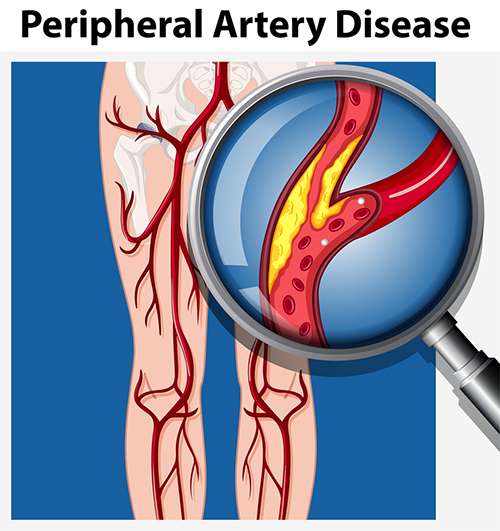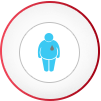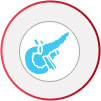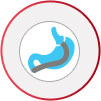Peripheral Arterial Disease

For the convenience of naming, Peripheral Arterial Disease refers to narrowing or blockages in the arteries that supply vital organs and limbs outside of the heart and brain. Often when your doctor mentions PAD, it refers to arterial disease in the lower limbs. However, PAD is often seen alongside arterial disease involving the heart and brain.
Do I have PAD?
Some of the common symptoms of PAD are
- Intermittent Claudication
- Rest-pain
- Ulcers and Necrosis (black toes)
Intermittent Claudication
Intermittent claudication is a condition characterised by pain and/or cramps in the lower leg muscles while walking and is relieved during rest. This type of pain that comes on with exertion and disappears with rest is referred to as intermittent claudication. When walking and exercising, the calf muscles need more oxygen to function, but the reduced blood flow does not carry enough oxygen. The pain may be felt as a dull ache or throbbing feeling.
When you present to our clinic with these symptoms, the diagnosis of claudication is made by a combination of clinical examination and a wide range of imaging tests (ultrasound, CT and MRA scans), and also by measuring and comparing blood pressures in the leg and arm (ankle-arm index).
Lifestyle Changes
In-addition it is also important to stop smoking as there is evidence that quitting smoking reduces progression of PAD. Healthy diet, weight reduction and regular exercise will also help improve the longterm outcome from PAD.
Medications
To treat intermittent claudication, initially your doctor will ensure that you are medically optimised and the risk factors for PAD are addressed. This will typically include starting a blood thinner such as Aspirin and also a cholesterol lowering agent called statin. Statin is often prescribed as it has been shown by research to improve the function of the inner cell lining of the blood vessel wall. Although these medications will not improve the distance you can walk without claudication pain, it has been shown to reduce the incidence of heart attacks and strokes in the future.
Invasive treatment is not generally recommended or required for patients with claudication. It may be necessary only if you do not respond to conservative treatment and the claudication symptoms are severely interfering with your daily activities and quality of life. Angioplasty is a keyhole procedure (endovascular surgery) that opens up narrowed and blocked arteries by inflating a small balloon inserted via the groin. After an angioplasty, a stent (wire mesh tube) may be placed within the artery to hold the artery open. Your surgeon may perform a bypass surgery, where a graft (healthy blood vessel removed from another part of the body) is attached to re-route blood away from the block.
Rest Pain, Ulcers and Necrosis
Rest pain is when the patient experiences pain in the legs especially the toes of the feet at all times. The pain is often worse at night time when trying to sleep with the legs up in the bed. These symptoms are a progression from intermittent claudication as the arterial disease advances and the blood supply to the legs is severely reduced. Often patients have to use very strong medications to get relief from pain symptoms. Minor knocks and bruises in the feet may struggle to heal due to the lack of adequate blood supply and nutrition. These then become ulcers and the tips of the toes may turn black (necrosis). Rest pain, ulcers and necrosis combined with reduced pressures (ABI) in the legs is referred to as Critical Limb Ischaemia(CLI). CLI is an indicator that the blood supply to the leg is severely depleted and here invasive intervention is warranted on an urgent basis to ensure that the leg does not deteriorate any further.
What are the risk Factors for PAD
 Cigarette Smoking
Cigarette Smoking
How does Cigarette smoking affect the arteries?
Smoking has been shown to be the strongest risk factor for PAD and there is four times higher risk of developing arterial disease in a smoker compared to a non-smoker. Along with this, there is unfortunately a higher risk of amputations and deaths in smokers. Smoking can cause inflammation of the cells lining the inside of the artery wall and this can in turn lead to plaque formation within the wall. As the plaque build-up continues, the artery can become narrowed or completely blocked. This can affect the blood supply to vital organs downstream.
How can I quit smoking?
There is a lot of evidence from research that shows that the benefits from quitting become evident within 2-5 years after smoking cessation. Smoking and nicotine is addictive and so quitting is not always easy and simple. A lot of research has been done looking into ways of improving the chances of quitting. The conclusion from all these large research trials is that Nicotine replacement therapy using gums, patches, nasal spray, inhalers and lozenges all help improve your chances of quitting. Please discuss with your specialist or your doctor who will be able to help you with this.
 Hypertension
Hypertension
What is Hypertension?
Blood exerts a certain amount of pressure on the walls of the arteries as it flows through the body. This is determined by the amount of blood pumped by your heart and the resistance to the flow exhibited by your vessels.
Hypertension or high blood pressure is a condition in which the long-term pressure within the blood vessels is elevated above the normal range. Over time, hypertension can damage your heart, blood vessels and other organs they supply, and lead to heart attack, stroke and heart disease.
Causes
The most common form of hypertension is primary or essential hypertension, which does not have an identifiable cause and develops over time. However, secondary hypertension is associated with an underlying condition.
Some of the factors that can increase your risk of developing hypertension include increasing age, smoking, excess alcohol intake, drug abuse, obesity, stress, poor diet, lack of exercise, underlying chronic condition such as diabetes and kidney disease, certain medications and also a family history.
Signs and symptoms of Hypertension
Hypertension is not usually associated with any visible signs or symptoms until the damage to the vessels and organs results in complications such as a stroke or heart attack. Severe hypertension may be accompanied by headache, nosebleed or shortness of breath.
Diagnosis
Screening for blood pressure should be performed at least once every 2 years after the age of 18. Blood pressure is measured using an inflatable arm cuff with a pressure gauge.
Blood pressure is measured in millimetres of mercury and consists of two numbers - the systolic pressure is the measurement as your heart contracts to pump blood and the diastolic pressure is the measurement as your heart relaxes. A measurement below 120 mmHg for systolic pressure and 80 mmHg for diastolic pressure is considered normal range. A systolic range of 120-139 and a diastolic range of 80-89 represents prehypertension, a state that increases your risk of heart disease. A systolic blood pressure above 140 and diastolic pressure above 90 indicates hypertension which can cause damage to your vital organs if left untreated.
Once diagnosed with prehypertension or hypertension you may be asked to measure your blood pressure at home and maintain a log. Your doctor will also evaluate your medical history and perform a physical examination. Blood and urine tests and an electrocardiogram, which measures your heart’s electrical activity may be ordered to assess heart disease.
Treatment options
Lifestyle Changes
In cases of mild hypertension, your doctor may recommend healthy lifestyle changes to lower your blood pressure. You are advised to eat a healthy diet with less salt, quit smoking, lower alcohol intake, exercise regularly and maintain an ideal weight.
Medications
When blood pressure cannot be controlled by lifestyle changes, your doctor will prescribe medication appropriate for your age and medical condition. You will be advised to visit your doctor regularly to have your blood pressure and overall health assessed.
 Hyperlipidaemia
Hyperlipidaemia
What is Hyperlipidaemia?
Hyperlipidaemia is a medical term that refers to abnormally high levels of fats, such as triglycerides or cholesterol in the blood. It is generally seen in overweight people who are on an unhealthy diet consisting mainly of foods rich in fat such as eggs, cheese and meat. It can also be seen in people who drink too much alcohol. The fat from these food items combines with proteins in the blood to form lipoproteins. These lipoproteins are classified into two types, namely, HDL/High density lipoproteins and LDL/Low density lipoproteins. The HDL lipoprotein is often referred to as “good cholesterol”, as it prevents narrowing and blockages of the arteries. On the contrary, LDL or the “bad cholesterol” tends to deposit along the walls of the arteries, leading to a condition called atherosclerosis or hardening of the arteries. Atherosclerosis increases your risk for heart attack and stroke.
Hyperlipidaemia does not cause any symptoms and is often diagnosed during routine screenings or annual health examination. If your doctor suspects that you are at risk of having a heart attack or stroke, a blood test will be ordered to determine your lipid levels.
Treatment for hyperlipidaemia includes lifestyle changes such as making healthy diet choices, following a regular exercise routine, avoiding fatty foods, quitting smoking, limiting alcohol and losing excess weight.
If conservative treatment measures do not lower your LDL levels to an acceptable level, your physician may prescribe medications such as statins to help.
 Diabetes
Diabetes
Diabetes is a chronic disorder characterised by the inability of the body to maintain blood glucose levels within normal limits. This results in hyperglycaemia, the presence of high sugar (glucose) levels in the blood. The level of glucose in the blood is regulated by insulin hormone. The normal level of glucose in the blood should be between 70 and 100 mg/dL (fasting) and <140 mg/dL (random). (There are different views about the normal range of blood glucose. Please discuss the same with your healthcare team.) Impaired production or function of insulin increases glucose levels in the blood.
There are 2 types of diabetes:
- Type 1 diabetes is an autoimmune disease, in which the insulin producing cells are mistakenly attacked by the body’s defence system; hence, decreasing the production of insulin and increasing the accumulation of blood sugar.
- Type 2 diabetes occurs either due to the reduced production of insulin or the inadequate use of the hormone produced by the various cells of the body. This is the most common type of diabetes.
Lastly, Gestational diabetes is a temporary condition, which occurs during pregnancy and resolves after child birth. However, it poses a future risk for the development of type 2 diabetes in the mother.
Anatomy
The pancreas is situated just below the stomach and produces enzymes for the digestion of food and also the hormones insulin and glucagon for the regulation of blood glucose. The pancreas consists of a group of cells called the islets of Langerhans, which produce and store the hormone. Carbohydrates in the food we eat are broken down to form glucose, which is either used immediately by the muscles and liver as energy or stored for later use. When levels of blood sugar start rising after a meal, the islets of Langerhans secrete insulin, which transports sugar to the cells. If the pancreas fails to produce sufficient amounts of insulin or the body’s cells are insensitive to the hormone, glucose starts accumulating in the blood stream, leading to diabetes.
Causes for Diabetes
The various causes of diabetes include:
- Obesity
- Sedentary lifestyle
- Viral infection or nutritional factor in childhood
- Heredity
- Old age
- Pregnancy
- Autoimmunity, when the body’s defence system attacks and destroys pancreatic cells
How does it impact the human body?
Diabetes causes damage to the cardiovascular system, eyes, kidneys, nerves, feet, skin and blood vessels. Gestational diabetes can lead to complications such as high birth weight, requiring C-section delivery, and preeclampsia or high blood pressure that could be life-threatening for both mother and child.
Symptoms
The common symptoms of diabetes mellitus are increased thirst, frequent urination, extreme hunger, unexplained weight loss, fatigue, blurred vision, delayed wound healing, dehydration, altered mental status and frequent infections.
Stages
Stages of diabetes are decided based on blood glucose levels. If your fasting blood glucose levels are between 100 and 125 mg/dL, then you are considered to be in the pre-diabetic stage. At this stage, although the blood sugar level is high it cannot be classified as diabetes and the sugar levels can be controlled by weight loss and exercise. Fasting blood glucose levels >126 mg/dL is considered a diabetic stage and will require medications to keep your blood sugar levels under control. The development of type 2 diabetes at a young age increases the risk of complications such as arterial disease and neuropathy.
Diagnosis
When you present to your doctor with the above symptoms, your doctor will order a few tests to diagnose diabetes:
Fasting blood glucose test: The fasting blood glucose test is the preferred test for diagnosing diabetes. A sample of blood is drawn after fasting overnight and tested for levels of glucose. Levels of 100 to 125 mg/dL is inferred as prediabetes, while levels more than 125 mg/dL on two or more separate tests on different days indicates diabetes.
- Random blood glucose test: A blood sample is taken randomly, at any time of day (regardless of whether you have eaten or not). Blood glucose levels of 200 mg/dL or higher indicates diabetes.
- Oral glucose tolerance test: It is commonly performed for diagnosing gestational diabetes, diabetes and pre-diabetes. In this test, a sample of blood is taken to determine fasting blood sugar level. Following this, a standard amount of sugar is provided orally and blood samples are taken at specific intervals within 2 hours to measure the blood glucose. Levels more than 200 mg/dL indicates diabetes, and levels 140 to 199 mg/dL indicates prediabetes.
Untreated
When left untreated, diabetes can affect various parts of the body:
- Eyes: Diabetic retinopathy, cataracts and glaucoma
- Kidney: diabetic nephropathy, progressive renal failure
- Nerves: diabetic neuropathy and erectile dysfunction
- Cardiovascular diseases: Early coronary artery disease, peripheral vascular disease, hypertension and ischemia
- Feet: Increased risk of infections, foot ulcers and amputations
- Slow wound healing
Treatment Options
Treatment of diabetes involves diet, exercise, medications and other lifestyle improvements. These will help to maintain normal blood sugar levels, and prevent or minimise complications of diabetes.
Lifestyle Changes
- Diet: Eat a consistent well-balanced diet that is high in fibre, and low in saturated fats and concentrated sweets. Meals should be taken at a regular interval and avoid long periods between meals.
- Exercise: Regular exercise in any form can help maintain a healthy weight and blood sugar levels within the normal range.
- Smoking and alcohol use: Stop smoking and limit consumption of alcohol.
Medications
- Medical treatment: Medicines are prescribed based on the type of diabetes, presence of associated medical problems, complications of diabetes, age and general health. There are drugs that can be taken orally and also treatment involving daily injection of insulin. It is given as two or three injections per day, generally around meal times.
- Treating complications: Your doctor will also include medications and treatments to prevent, control and treat other associated conditions.
Regular monitoring of blood glucose is necessary to prevent long-term complications of the disease.
Alternative therapy
Some other treatments that are suggested to control diabetes include:
-

Pancreatic Transplantation
- Pancreatic transplantation: This method can be indicated for type 1 diabetes. If the pancreas transplant is successful, you would no longer require insulin. However, the treatment may have major side effects like organ rejection, which can be more fatal than diabetes itself. Hence, this treatment is suggested only in severe cases where diabetes cannot be controlled through any other means.
-

Bariatric Surgery
- Bariatric surgery: Weight loss surgery is a well established surgical treatment option for patients with type 2 diabetes and obesity. Though it is not a direct treatment for diabetes, weight loss surgeries may help to reduce blood sugar in patients with a BMI of 35 and above.
